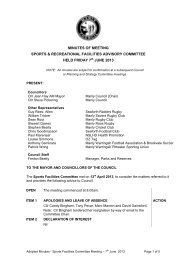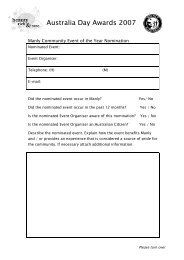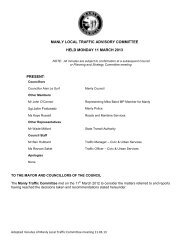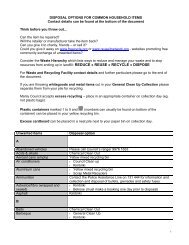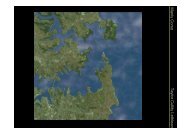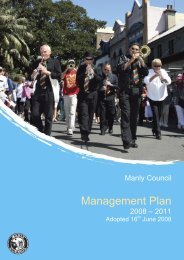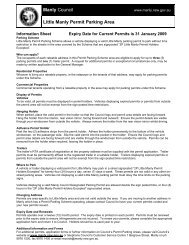Manly Lagoon Dredging Project - Manly Council - NSW Government
Manly Lagoon Dredging Project - Manly Council - NSW Government
Manly Lagoon Dredging Project - Manly Council - NSW Government
- No tags were found...
You also want an ePaper? Increase the reach of your titles
YUMPU automatically turns print PDFs into web optimized ePapers that Google loves.
<strong>Manly</strong> <strong>Lagoon</strong> <strong>Dredging</strong> <strong>Project</strong> – Review of Environmental FactorsPrepared for <strong>Manly</strong> and Warringah <strong>Council</strong>sImproving benthic habitat conditions as a result of an improved flushing regime.Water Depths and BathymetryThe aim of the dredging activities is to increase the depths of <strong>Manly</strong> <strong>Lagoon</strong> in the proposeddredging areas. According to the dredging plans (Appendix J), approximately 97% ofmaterial to be dredged will be removed from the 0 to 1m depth range, while only 3% ofmaterial to be dredged will be removed from the 1 to 1.2m depth range.The dredging activities will alter the bathymetry of <strong>Manly</strong> <strong>Lagoon</strong>, hence the proposal willimpact on lagoon hydrology in a positive manner in the long term by deepening certain areasof the lagoon and allowing greater tidal exchange and flushing to occur. The aim of thedredging works is to increase water depths by removing relatively recent sedimentation soas to re-establish the natural water depths. The design of the dredging works will avoid thecreation of isolated deep holes, which may potentially become anoxic.FloodingLarge rainfall and/or flood events during the works can lead to significant environmentalimpacts in a number of ways including:Exceeding the capacity of the sediment and erosion control measures;Washing loose sediment or stockpiled materials from the bank into downstreamwater bodies;Causing the silt curtains to fail if flow velocities within the lagoon are increasedsubstantially. This risk is greatest between February and June (Section 5.2);Destabilising the geobags from their position in Nolan Reserve; andMobilising potential contaminants from within the contractor’s compound.Overburden Water from Dewatering ActivitiesOverburden water from the dewatering process is proposed to be returned to the lagoon in acontrolled manner, providing testing proves it suitable. The water will be collected in bundedareas during dewatering.Results from the trial dredging (Cardno Ecology Lab, 2009c; Appendix C) indicate thatlevels of some metals, Enterococci and nutrients in the overburden water during dewateringexceed both ANZECC (2000) Guidelines values and background levels in the lagoon watersampled (Cardno Ecology Lab, 2009c). These parameters include chromium, copper, leadand zinc, ammonia as N, TP and Enterococci; however it should be noted that water qualitymonitoring by Cardno Ecology Lab (2010; Appendix H) in the lagoon in July and August2009 indicated that at that time copper and zinc exceeded ANZECC (2000) Guidelines inlagoon waters.It should also be noted that the trial dredging only removed finer surface sediments from thelagoon, which generally contain higher levels of heavy metals nutrients and microorganismsthan deeper sediments. As the <strong>Manly</strong> <strong>Lagoon</strong> <strong>Dredging</strong> <strong>Project</strong> would disturb a greatervolume of deeper sediments with a lower proportion of fine material, overburden water2 July 2010 Cardno (<strong>NSW</strong>/ACT) Pty Ltd 65H:\Doc\2010\Reports.2010\Rep2580v4.doc



